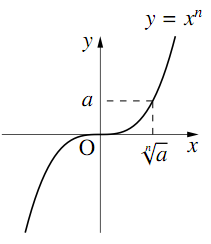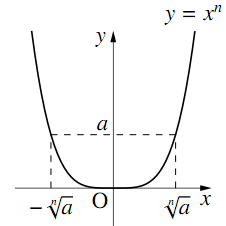累乗と累乗根
同じ数$x$を何回か掛けて$a$という値になるとき、$x$を「$a$の累乗根」という。ここでは、累乗根に関する計算法則を学ぶ。
累乗と指数法則
累乗と指数法則について
累乗と指数法則について
\FTEXT 数学Iで学んだように, 数$a$の$n$個の積 $ \begin{array}{c} n個 \\ \overbrace{a\times a\times\cdots\times a}^{} \end{array} $ を $a^n$と書き,「$a$の$n$乗」と読む.つまり
\[ \begin{array}{c} \underbrace{a\times a\times\cdots\times a}_{}=a^n \\ n個 \qquad \end{array} \]である. このとき,$a$の右上に乗っている数$n$のことを$a^n$の指数(index number)という. $a^1 = a$とし,特に,$a^2$のことを$a$の平方(square), $a^3$のことを$a$の立方(cube)という. また,$a,a^2,a^3,\cdots$を総称して$a$の累乗(power)という.
累乗に関して
- $a^2\times a^4=
\begin{array}{c}
\\
\\
(\underbrace{a\times a}_{}) \\
2個
\end{array}
\times
\begin{array}{c}
\\
\\
(\underbrace{a\times a\times a\times a}_{}) \\
4個
\end{array}
$
$ =a^6~(=a^{2+4})$ - $(a^2)^4=
\begin{array}{c}
\\
\\
(\underbrace{a\times a}_{}) \\
2個
\end{array}
\begin{array}{c}
\\
\\
(\underbrace{a\times a}_{}) \\
2個
\end{array}
\begin{array}{c}
\\
\\
(\underbrace{a\times a}_{}) \\
2個
\end{array}
\begin{array}{c}
\\
\\
(\underbrace{a\times a}_{}) \\
2個
\end{array}
$
$ =a^8~(=a^{2\times4})$ - $(a\times b)^4$
$ =(a\times b)\times(a\times b)\times(a\times b)\times(a\times b)$
$ =a^4\times b^4$
などの例からわかるように,一般に次のような指数法則(law of exponents)が成り立つ.
指数法則
$x,y$が自然数のとき,次の関係が成り立つ.
- $a^xa^y=a^{x+y}$
- $({a}^{x})^{y}=a^{xy}$
- $ (ab)^x=a^xb^x$
累乗根
累乗根とは何か
累乗根とは何か
$2$乗して$3$になる数を$3$の平方根とよび$\pm\sqrt{3}$と表していた. ここでは,$2$乗だけに限らず,$3$乗,$4$乗,$\cdots$の場合についても拡張して考えてみよう.
$n$乗根の定義
$n$を自然数とする.$n$乗すると$a$になる数,つまり
\begin{align} x^n=a \end{align}となる$x$の値を,$a$の$n$乗根($n$th root)という.
たとえば,$2^3 = 8$なので,$2$は$8$の$3$乗根である. また,$2^4 = 16$であり$( − 2)^4 = 16$であるから, $− 2$と$2$はともに$16$の$4$乗根である.
特に,$2$乗根を平方根(square root), $3$乗根を立方根(cubic root)という. また,$2$乗根,$3$乗根,$4$乗根,$\cdots$を総称して, 累乗根(radical root)という.
$a$の$n$乗根の表し方
$0$でない実数$a$の$n$乗根は,次のようになる.

$n$が奇数のとき
$y = x^n$のグラフは図のようになるので(たとえば$n = 3$として$x$を変化させて計算してみるとよい),$a$の正負に関係なく,$a$の$n$乗根はただ1つだけ存在し,それを$\sqrt[n]{a}$($n$乗根$a$と読む) と表す.
$\sqrt[n]{a}$の正負は$a$の正負と同じになる.
たとえば,$2^3 = 8$であるから,$\sqrt[3]{8}=2$である.
$n$が偶数のとき
$y = x^n$のグラフは図のようになるので(たとえば$n = 4$として$x$を変化させて計算してみるとよい), $a$が正のときに正と負の2つの$n$乗根が存在する. そのうち正のものを$\sqrt[n]{a}$と表し,負のものを$-\sqrt[n]{a}$と表す.
たとえば,$2^4 = 16,( − 2)^4 = 16$であるから,
$\sqrt[4]{16}=2,-\sqrt[4]{16}=-2$である.
なお,$a$が負のときには,$a$の$n$乗根は存在しない.
$0$は何乗しても$0$なので,$0$の累乗根はすべて$0$である.つまり,$\sqrt[n]{0}=0$である.

累乗根の値を求める-その1-
次の値を求めよ.
- $\sqrt[3]{-27}$
- $-\sqrt[4]{81}$
- $\sqrt[6]{0.000001}$
- $\sqrt[3]{0.125}$
$− 27$の$3$乗根,つまり$x^3 = − 27$となる$x$は $− 3$である.
よって
\begin{align} \sqrt[3]{-27}=\boldsymbol{-3} \end{align}$81$の$4$乗根, つまり$x^4 = 81$となる$x$は $− 3$と$3$である. $-\sqrt[4]{81}$は負の方を表すから
\begin{align} -\sqrt[4]{81}=\boldsymbol{-3} \end{align} $\blacktriangleleft$正の方の$\sqrt[4]{81}=3$にマイナスがつき $− 3$となると考えても良い$0.000001$の$6$乗根, つまり$x^6 = 0.000001$となる$x$は $− 0.1$と$0.1$である. $ \sqrt[6]{0.000001}$は正の方を表すから
\begin{align} \sqrt[6]{0.000001}=\boldsymbol{0.1} \end{align}$0.125$の$3$乗根, つまり$x^3 = 0.125$となる$x$は$0.5$である.よって
\begin{align} \sqrt[3]{0.125}=\boldsymbol{0.5} \end{align}
$\blacktriangleleft$
\begin{align} &x^3=-27\\ &\Leftrightarrow~x^3+27=0\\ &\begin{array}{c} \Leftrightarrow~(x+3)\underbrace{(x^2+3x+9)}_{}=0\\ \qquad\quad正 \end{array} \end{align}$\blacktriangleleft$
\begin{align}&x^4=81\\ &\Leftrightarrow~x^4-81=\\ &\Leftrightarrow~(x^2-9)(x^2+9)=0\\ &\begin{array}{c} \Leftrightarrow~(x-3)(x+3)\underbrace{(x^2+9)}_{}=0\\ \qquad\qquad\qquad正 \end{array} \end{align}$\blacktriangleleft$
\begin{align}&x^6=0.000001\\ &\Leftrightarrow~x^6-0.000001=0\\ &\Leftrightarrow~(x^3-0.001)(x^3+0.001)=0\\ &\begin{array}{c} (x-0.1)\underbrace{(x^2+0.1x+0.01)}_{}=0\\ \qquad正 \end{array} \end{align}または
\begin{align} \begin{array}{c} (x+0.1)\underbrace{(x^2-0.1x+0.01)}_{}=0\\ \qquad正 \end{array} \end{align}$\blacktriangleleft$
\begin{align} &x^3=0.125\\ &\Leftrightarrow~x^3-0.125=0\\ &\begin{array}{c} \Leftrightarrow~(x-0.5)\underbrace{(x^2+0.5x+0.25)}_{}=0\\ \qquad\qquad正 \end{array} \end{align}$a$の$n$乗根の表し方でもみたように, 負の数$a$の$n$乗根は存在しないことがある. 以下では簡単のため,特にことわりのない限り正の数$a$の$n$乗根について考えることにする.
一般に,累乗根について,次のことが成り立つ.
累乗根の基本性質
$a > 0,b > 0$で,$m,n,l$が自然数のとき,次の等式が成り立つ.
- $\left(\sqrt[n]{a}~\right)^n=a$
- $\sqrt[n]{a}\sqrt[n]{b}=\sqrt[n]{ab} $
- $\dfrac{\sqrt[n]{a}}{\sqrt[n]{b}}=\sqrt[n]{\dfrac{a}{b}}$
- $\left(\sqrt[n]{a}~\right)^m=\sqrt[n]{a^m}$
- $\sqrt[m]{\sqrt[n]{a}}=\sqrt[mn]{a}$
- $\sqrt[n]{a^m}=\sqrt[nl]{a^{ml}}$
この基本法則により,たとえば$\sqrt[4]{2}\sqrt[4]{8}$は2.と4.と1.を使い
\begin{align} &\sqrt[4]{2}\sqrt[4]{8}=\sqrt[4]{2\times8}=\sqrt[4]{2^4}=(\sqrt[4]{2})^4=2 \end{align}と計算できる.
【証明】
$\sqrt[n]{a}$の定義は,$n$乗して$a$になる数であるから,$\sqrt[n]{a}$を$n$乗すれば当然$a$になる.
$\sqrt[n]{a}>0,\sqrt[n]{b}>0$より,$\sqrt[n]{a}\sqrt[n]{b}>0$であり,
$\left(\sqrt[n]{a}\sqrt[n]{b}\right)^n=\left(\sqrt[n]{a}\right)^n\left(\sqrt[n]{b}\right)^n$ $\blacktriangleleft$指数法則の3.
$=ab$ $\blacktriangleleft$指数法則の1.
であるから,左辺の$\sqrt[n]{a}\sqrt[n]{b}$は,$ab$の$n$乗根のうち正のもの,すなわち$\sqrt[n]{ab}$を表す.
$\sqrt[n]{a}>0,\sqrt[n]{b}>0$より,$\dfrac{\sqrt[n]{a}}{\sqrt[n]{b}}>0$であり
$\left(\dfrac{\sqrt[n]{a}}{\sqrt[n]{b}}\right)^n=\dfrac{\left(\sqrt[n]{a}\right)^n}{\left(\sqrt[n]{b}\right)^n}$ $\blacktriangleleft$指数法則の3.
$=\dfrac{a}{b}$ $\blacktriangleleft$指数法則の1.
であるから,左辺の$\dfrac{\sqrt[n]{a}}{\sqrt[n]{b}}$は,$\dfrac{a}{b}$の$n$乗根のうち正のもの, すなわち$\sqrt[n]{\dfrac{a}{b}}$を表す.
暗記累乗根の基本性質の証明
指数法則を利用して,累乗の基本性質の4.~6.を証明せよ.
4.$\left(\sqrt[n]{a}\right)^m>0$であり
$\left\{\left(\sqrt[n]{a}\right)^m\right\}^n=\left(\sqrt[n]{a}\right)^{mn}$ $\blacktriangleleft$ 指数法則2.
$=\left\{\left(\sqrt[n]{a}\right)^n\right\}^m$ $\blacktriangleleft$ 指数法則2.
$=a^m$ $\blacktriangleleft$ 累乗根の基本性質1.
であるから,左辺の$\left(\sqrt[n]{a}\right)^m$は,$a^m$の$n$乗根のうち正のものを表す. これは,右辺の$\sqrt[n]{a^m}$にほかならない.
5.$\sqrt[m]{\sqrt[n]{a}}>0$であり
$\left\{\sqrt[m]{\sqrt[n]{a}}\right\}^{mn}=\left\{\left(\sqrt[m]{\sqrt[n]{a}}\right)^m\right\}^n$ $\blacktriangleleft$ 指数法則2.
$=\left(\sqrt[n]{a}\right)^n$ $\blacktriangleleft$ 累乗根の基本性質1.
$=a$ $\blacktriangleleft$ 累乗根の基本性質1.
であるから,左辺の$\sqrt[m]{\sqrt[n]{a}}$は,$a$の$mn$乗根のうち正のものを表す. これは,右辺の$\sqrt[mn]{a}$にほかならない.
6.$\sqrt[n]{a^m}>0$であり
$\left\{\sqrt[n]{a^m}\right\}^{nl}=\left\{\left(\sqrt[n]{a^m}\right)^n\right\}^l$ $\blacktriangleleft$ 指数法則2.
$=\left({a^m}\right)^l$ $\blacktriangleleft$ 累乗根の基本性質1.
$=a^{ml}$ $\blacktriangleleft$ 指数法則2.
であるから,左辺の$\sqrt[n]{a^m}$は,$a^{ml}$の$nl$乗根のうち正のものを表す. これは,右辺の$\sqrt[nl]{a^{ml}}$にほかならない.
累乗根の値を求める-その2-
次の式を簡単にせよ.
- $\sqrt[3]{4}\sqrt[3]{16}$
- $\dfrac{\sqrt[5]{96}}{\sqrt[5]{3}}$
- $\sqrt[3]{216}$
- $\sqrt[3]{\sqrt{729}}$
- $\sqrt[6]{8}$
- $\sqrt[15]{27}$
- \begin{align} \sqrt[3]{4}\sqrt[3]{16}=\sqrt[3]{4\times16}\\ =\sqrt[3]{4^3}=\boldsymbol{4} \end{align} $\blacktriangleleft$ 累乗根の基本性質2.
- \begin{align} \dfrac{\sqrt[5]{96}}{\sqrt[5]{3}}=\sqrt[5]{\dfrac{96}{3}}\\ =\sqrt[5]{32}=\sqrt[5]{2^5}=\boldsymbol{2} \end{align} $\blacktriangleleft$ 累乗根の基本性質3.
- \[\sqrt[3]{216}=\sqrt[3]{6^3}=\boldsymbol{6}\]
- \begin{align} \sqrt[3]{\sqrt{729}}=\sqrt[6]{729}\\ =\sqrt[6]{3^6}=\boldsymbol{3} \end{align} $\blacktriangleleft$ 累乗根の基本性質5.
- \begin{align} \sqrt[6]{8}=\sqrt[6]{2^3}\\ =\boldsymbol{\sqrt{2}} \end{align} $\blacktriangleleft$ 累乗根の基本性質6.
- \begin{align} \sqrt[15]{27}=\sqrt[15]{3^3}\\ =\boldsymbol{\sqrt[5]{3}} \end{align} $\blacktriangleleft$ 累乗根の基本性質6.